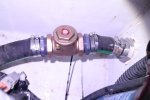My point is that you should not add weight to fix having too much weight. Adding weight puts more boat below the waterline.
Shifting or moving weight may accomplish something very useful. Your experiment moved bodies.
yes, there is a pivot point. Yes, in some displacement hulls adding ballast is important. Its not because the vessel is too heavy, its because some area of the vessel is too light.
But in the case of an outboard planing hull where you have too much weight aft, adding extra weight forward is not "the fix".
Eventually you will add temporary weight like gear and fuel and bodies and then you will have too much weight forward.
So using your experiment. Suppose you sent a 100 pound person forward and it raised the scuppers right where you want them.
So you add 100 pounds of sand to the bow. What happens now when a 200 pound person goes up to the bow?


